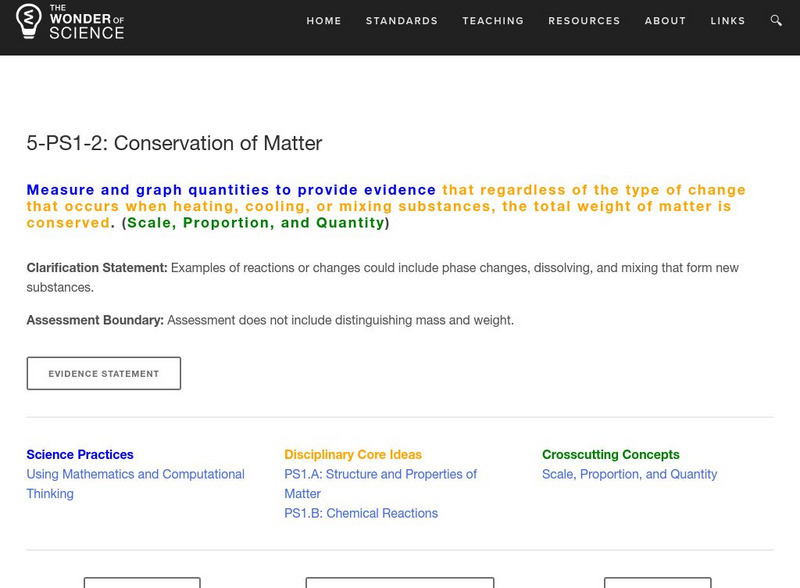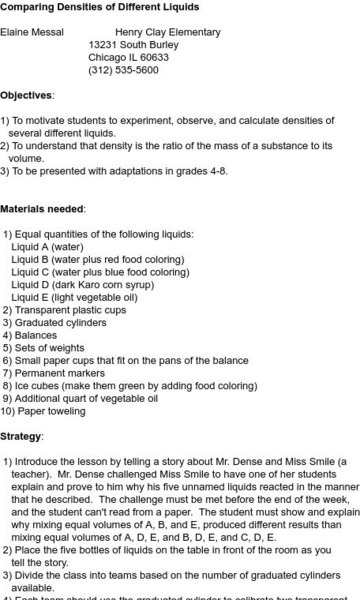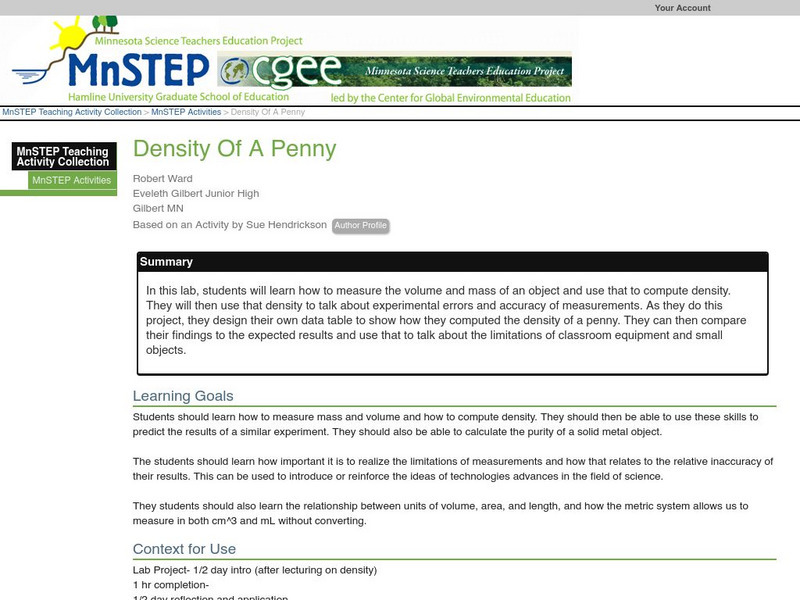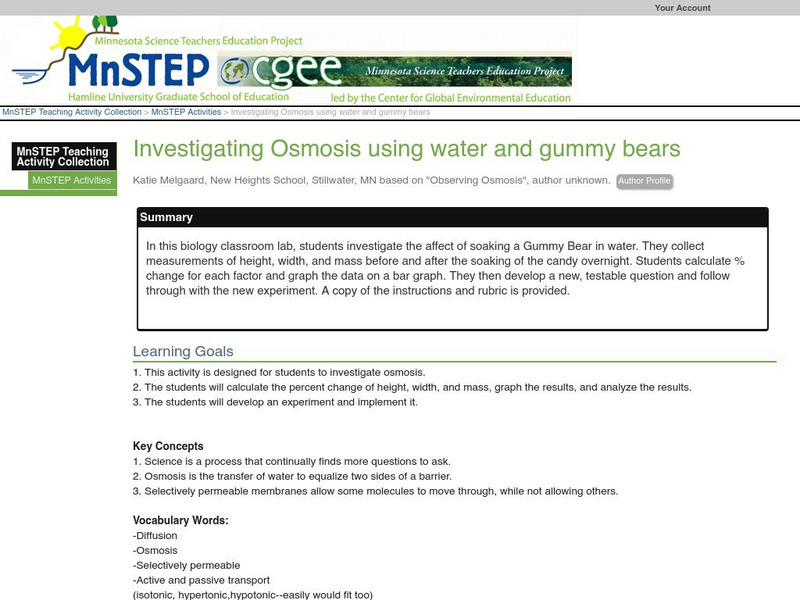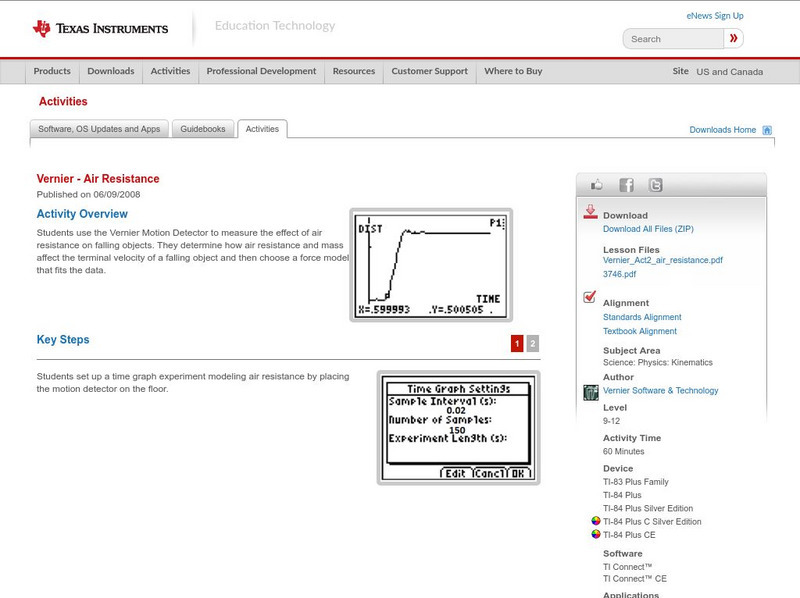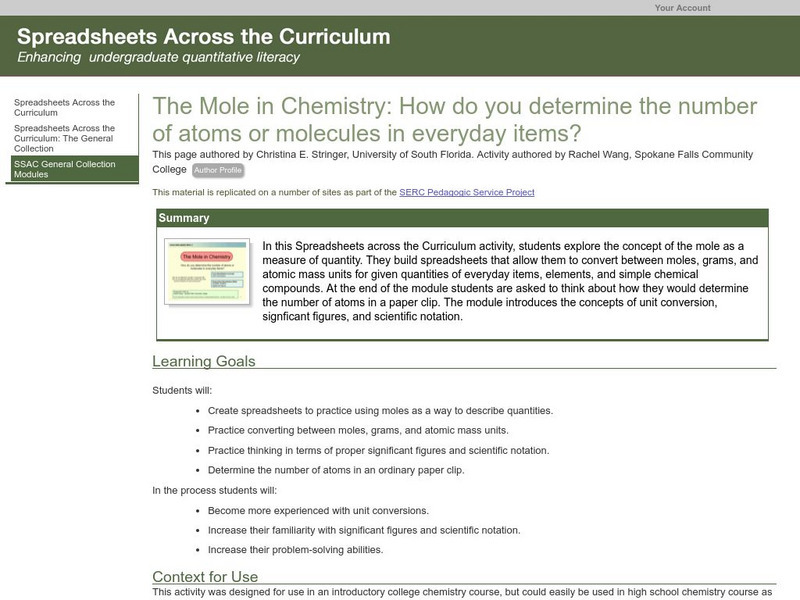TeachEngineering
Teach Engineering: Measure Twice, Cut Once
Students learn the metric units engineers use to measure mass, distance (or length) and volume. They make estimations using these units and compare their guesses with actual values. To introduce the concepts, the teacher needs access to...
Science Education Resource Center at Carleton College
Serc: Measuring and Comparing Matter
In this activity, students will measure a variety of different materials from the classroom to determine how much matter is found in these materials then determine the mass of these materials using the same volume for each. The data will...
PBS
Pbs Teachers: Scientific American: The Intimate Machine: Weighing In
Explore the "intelligent floor," which contains sensors that can track movements, and emulate the weighing technique associated with this technology. Explore the relationship between volume and mass and the difference between accuracy...
University of Texas
Inside Mathematics: Fruits and Vegetables [Pdf]
This task challenges a student to use understanding of measurement to convert accurately between units of weight.
Science Education Resource Center at Carleton College
Serc: Chemical Changes: Reacting an Acid and Base
In this chemistry lab, students will investigate chemical changes that occur when acids and bases react. It is meant to introduce the concepts of chemical changes, gases have mass, conservation of mass, and balancing equations. Students...
PBS
Pbs Mathline: Sand Babies (Pdf) [Pdf]
In this engaging lesson, students use a variety of measurement strategies in creating their own Sand Babies. Students explore standard and non-standard measurements, area, data collection and analysis, and graphing. Adaptations are...
The Wonder of Science
The Wonder of Science: 5 Ps1 2: Conservation of Matter
On this site, find a variety of materials to help students understand the conservation of matter. Create lessons that allow students to measure and graph quantities that could show even if matter is heated, cooled or combined with other...
Science and Mathematics Initiative for Learning Enhancement (SMILE)
Smile: Comparing Densities of Different Liquids
This lab experiment has students observe and compare the density of five different liquids while measuring mass and volume.
Better Lesson
Better Lesson: Math Trash
A lesson where students collect trash, sort, and record the mass in grams. They will use their knowledge of numbers to figure out what category of trash had the most. The biggest idea of the lesson is that students will be more likely to...
Utah Education Network
Uen: Super Paper Planes
Activity helps students understand force, mass, and measurement.
American Chemical Society
Middle School Chemistry: Density of Water
Students discover the concept that density is a characteristic property of water by measuring the volume and mass of water and calculating its density.
Science Education Resource Center at Carleton College
Serc: Density of a Penny
Students learn how to measure the volume and mass of an object and use that to compute density. They will then use that density to talk about experimental errors and accuracy of measurements.
Science Education Resource Center at Carleton College
Serc: Angle of Repose
In this activity, young scholars measure the maximum slope at which grains are stable (the angle of repose). They explore how different properties of the sediment influence slope stability and lead to different slope failures (mass...
TeachEngineering
Teach Engineering: Air Under Pressure
Students are introduced to air masses, with an emphasis on the differences between and characteristics of high - versus low-pressure air systems. Students also hear about weather forecasting instrumentation and how engineers work to...
Illustrative Mathematics
Illustrative Mathematics: G Mg How Many Cells Are in the Human Body?
About how many cells are in the human body? The purpose of this task is for students to apply the concepts of mass, volume, and density in a real-world context. Aligns with G-MG.A.2.
Alabama Learning Exchange
Alex: Weight vs. Capacity
This lesson plan will introduce students to measuring weight, mass, volume, and capacity using metric and cutomary units. This lesson plan was created by exemplary Alabama Math Teachers through the AMSTI project.
Science Education Resource Center at Carleton College
Serc: Air Is Matter
It's difficult at times for younger young scholars to realize that air has mass. Matter is something that has volume (takes up space) and has mass (*can be weighed). Air does take up space, even if we can't see it, and air has weight,...
Science Education Resource Center at Carleton College
Serc: Newton's Second: Having a Ball With Motion
Students will create a gravity ball launcher to demonstrate their understanding of mass, force, momentum, and motion. The students will use critical thinking, measurement, and observation and analysis of data to make changes and improve...
Science Education Resource Center at Carleton College
Serc: Investigating Motion: What Causes Objects to Move?
Young scholars will have an opportunity to determine what makes everyday objects move. Students will be given objects and asked to make predictions on how far each object will move after they blow on it. Then they will measure the...
Alabama Learning Exchange
Alex: Volume
Learners will learn the concept of volume by determining the amount of sand that is needed to fill the long-jump pit at their school (or any rectangular- or square-shaped container). This lesson will explain the importance of knowing how...
Science Education Resource Center at Carleton College
Serc: Investigating Osmosis Using Water and Gummy Bears
In this biology classroom lab, students investigate the affect of soaking a Gummy Bear in water. They collect measurements of height, width, and mass before and after the soaking of the candy overnight. Students calculate % change for...
Texas Instruments
Texas Instruments: Air Resistance
Young scholars use the Motion Detector to measure the effect of air resistance on falling objects. They determine how air resistance and mass affect the terminal velocity of a falling object and then choose a force model that fits the data.
Science Education Resource Center at Carleton College
Serc: Mn Step: Statistical Analysis of Lincoln
For this activity, students first work in groups to collect information about a set of pennies. They measure and record the mass for each one in a table using a spreadsheet program if possible. They also record its year and, for 1982...
Science Education Resource Center at Carleton College
Serc: The Mole in Chemistry: Determining the Number of Atoms in Everyday Items
Students explore the concept of the mole as a measure of quantity. They build spreadsheets that allow them to convert between moles, grams, and atomic mass units for given quantities of everyday items, elements, and simple chemical...
Other popular searches
- Measuring Mass of Balloons
- Measuring Mass and Weight
- Measuring Mass and Volume
- Measuring Mass Activity
- Tools for Measuring Mass
- Measuring Mass Triple Beam
- Measuring Mass Stations
- Measuring Mass With Scale
- Measuring Mass Biology
- Measuring Mass Centers
- Measuring Mass Worksheet
- Measuring Mass Math
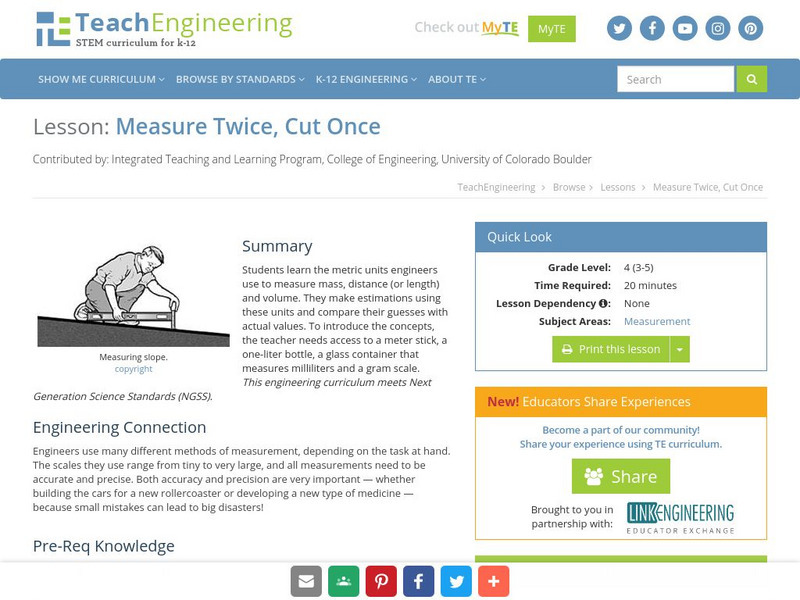


![Inside Mathematics: Fruits and Vegetables [Pdf] Lesson Plan Inside Mathematics: Fruits and Vegetables [Pdf] Lesson Plan](https://d15y2dacu3jp90.cloudfront.net/images/attachment_defaults/resource/large/FPO-knovation.png)

